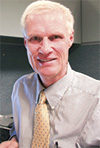The extent of our lives can be told in stories. The art of composing the story, as essay or poem or detailed biography, are together the composition of a life. The stories of loss and then redemption, the essays of cognition and then art, the poems of metaphors and then enlightenment, and the biographies of chronology and then honest reflection, are together the validation and acknowledgment of a life lived and given.
As children, we have yet to discover ourselves except through play. We grow up on farms if we are lucky. We watch animals give birth, plants grow, trees lose their leaves, snow fall in winter and the sliver of a corn plant protrude from the brown soil in spring.
We enter college and begin to ask why these occur. We learn the sciences of understanding; water flow and energy thermodynamics and chemical bonding and Euclid mathematics. We learn cognitive skills based upon deduction … that can be the foundation of something new.
Problem-solving is based, therefore, upon a somewhat standardized method of logic. Science itself is based upon the testing of a hypothesis; the solvation is conjecture until we use standardization (method) to test the answer.
College is, at least in the context of the sciences, the embarkation of measurement and data, and then bringing knowledge to those data. The hypothesis of any scientific field is seeking to understand something that can be measured, and therefore the compilation of data, from which yield analysis or analyses.
We enter the workforce upon graduation. Learning continues if we are true to our field. We realize that indeed, the complexity of the field is overwhelming compared to the two-dimensional chalkboard or computer screen.We realize the world, the physical world, is four-dimensional. X and Y, the planimetric, Z, the vertical to obtain volume, and then time, T, to obtain flux and flux density.
A classic example is soil fertility: The planimetric is the field size (borders) in acres, the sampling depth (30 cm perhaps) for a volume and then several years’ sampling for trend or flux analyses (plural). All agronomists know the true measure of fertility is better defined as a four-dimension flux rather than a three-dimension state.
In the field, we learn the interconnection of systems. We learn that crop production is the result of many processes and phenomenon … and nearly all of them are dependent on what we call stochastic behavior. A stochastic system is one not bound; an example is solar radiation as a function of energy input onto a photosynthetic pigment in a green leaf.
In the field, we learn that much of what we learned in the classroom, as rote or as model, lacks the precision of expected output. Using the laws of thermodynamics, the metrics of calculus and the code of digital software, mechanism is only predictive, and we realize that historical performance, as anecdote or anecdotal, may in fact guide our future prediction, but guide only.
In the field, we return year after year, and soon decades pass. As they do, our view of the field changes. Yes, many scientists gain much respect for having honed their skill working in the field for 20 or 30 or 40 years.
Yet many of them are transformed. The transformation begins with humility. This may seem odd to you. But if we define “a good scientist” as one who gains a deeper understanding of the field, as per inductive thought and consilience, then an apt description of humility is movement toward wisdom.
In the later years of a career, the humility of a scientist is, in essence, the transformation of thought to wisdom from knowledge. What is wisdom?
We may define it this way: The scientist knows the boundary or boundaries of his or her science. The soil physicist clearly knows boundaries of three- and four-dimensional space and time.
The soil physicist, as cognitive thinker, understands behavior of water flow to the atmosphere, from the travel (xylem) transpiration and the removal of soil water via hydraulic gradient and hydrogen bonding. The soil physicist, however, is limited by mechanical behavior and must admit a portion of the field is clearly in the realm of stochasticity.
This transformation, the understanding of the field as more than just rote and modeling, is in itself humbling. We enter the field and walk across the soil. We may be walking in a cornfield that is hundreds of acres large or the small corner of a pasture paddock … we may have an inventory sheet that is filled out.
The cropping history, the irrigation and tillage and planting history, the harvest history, the decades of soil fertility analyses, the land ownership title and the boundary of a tax lot or land tract.
But if we stop our walk and look down, the realm of a surface foot is overwhelming … the interconnectedness of the physical world on the surface and beneath, the expiration of carbon dioxide and methane, the leaching of substrates no longer absorbed, the soil animals that can be seen and those not, the biota influenced by water regime and temperature, and the roots and shoots of plants growing. We cannot explain what we see in totality. We can only humbly participate with our presence.
Humility includes knowing that our presence here is not unique. Before we enter, the footsteps of our ancestors are here. They will be after we leave as well. Why is this important? One reason may be to understand that we are pilgrims here … our path is akin to paths by others.
Centuries ago, a farmer may have grown a cereal here or grazed livestock here or harvested a pine forest or cleared land with a team of horses. The anthropological influence (anthropomorphic) is part of the landscape … the influence and caliber of pilgrims, be they wanderers or landowners, have established a culture here in this field.
A grandfather sits with a grandson on an old tractor. Later, that grandson sits in a truck driven by his father. Later, the grandson drives a combine while his wife sits in the jump seat. At some point, grandson is now a father, and his daughter rides with him as hay is baled.
And in two decades, a grandson now sits on a new tractor; his grandfather, once a grandson sitting on an old tractor, sits beside him watching a tractor steer itself with the aid of a constellation of satellites.
In the context of a field, the scientist is mere pilgrim; yet in discerning wisdom as some part of himself that is what we may call consilience, the composition of a scientist as story, essay, poem and biography is here, writ large – here in the field.
Once wisdom is humbly found, that is the transformation of a scientist to participant and pilgrim from the mechanistic model of knowledge brought forth from data as measurement; then we have found the realm of the humanities, as art.
The loveliness of this life composition, the transformation to art from the mechanics of determinism, is thus the reward of enlightenment, the journey of bliss, the pilgrimage of participation and the philosophy of knowing the boundary or bounds of science that is (or are) just a small glimmer of the entirety of understanding.
The humanities, the arts and the wisdom of what we may call critical or deep thought are brought about in the cadence of humility. To admit we do not know everything, or really very much at all, is the gift of humility.
At this point, a career is already established; the rationale to make claim for brilliance and seek prominence is easily washed away. We are comfortable with our pilgrimage and readily accept our role as mere participants.
Only when wisdom is discovered can the scientist truly know the field as The Field. In the context of the phrase written over and over: “The Beauty of the World,” lies the steps of a scientist entering the field over and over, in the space and time quadrants of the outer journey that is, humbly and participatory, the inner journey that is the story, the essay, the poem and the biography. It is a portrait of a scientist as art.
And it is everywhere … In The Field, In The Field, In The Field. PD

Mike Gangwer
Agricultural Scientist





